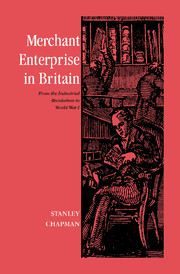Book contents
- Frontmatter
- Contents
- List of figures
- List of tables
- Preface
- Abbreviations used in the footnotes
- Introduction: approaches and concepts
- Part I The setting
- Part II New Streams Of Enterprise
- Part III Response to instant communication
- Part IV Conclusions
- Manuscript sources
- Index of firms and people
- Index of places
- Index of subjects
Introduction: approaches and concepts
Published online by Cambridge University Press: 20 March 2010
- Frontmatter
- Contents
- List of figures
- List of tables
- Preface
- Abbreviations used in the footnotes
- Introduction: approaches and concepts
- Part I The setting
- Part II New Streams Of Enterprise
- Part III Response to instant communication
- Part IV Conclusions
- Manuscript sources
- Index of firms and people
- Index of places
- Index of subjects
Summary
During the course of the last few years the period of British history conventionally known as the Industrial Revolution has lost some of its earlier significance as a watershed period. No doubt there is an element of conditioning by later twentieth-century experience in this attitude, for as British economic growth has looked less impressive compared with some of its competitors, so its interpreters have sought for the less spectacular and more evolutionary elements in its development, including the experience of earlier centuries. The ‘revolutionary’ feature of British economic and social history was taken to be the dramatic growth of the ‘great staple’ industries of last century – textiles, iron and coal – and their social consequences, and historians showed little interest in what had happened elsewhere in the economy, unless it was related to these major themes. The recent revisions, in suggesting more gradual growth in the old staples, has also served to rekindle interest in some of the continuities of economic and social life that were more taken for granted by contemporaries. Not the least is the traditional British interest in trade and finance.
It must be admitted that econometric measures of the changing structure of the British economy in the Industrial Revolution period, though exhibiting impressive statistical skill, can be no more than ‘controlled conjectures’. Moreover, the bulk of the data processed is still drawn from the traditional industries, with little serious attempt to measure change in the service sectors of the economy independently.
- Type
- Chapter
- Information
- Merchant Enterprise in BritainFrom the Industrial Revolution to World War I, pp. 1 - 18Publisher: Cambridge University PressPrint publication year: 1992

